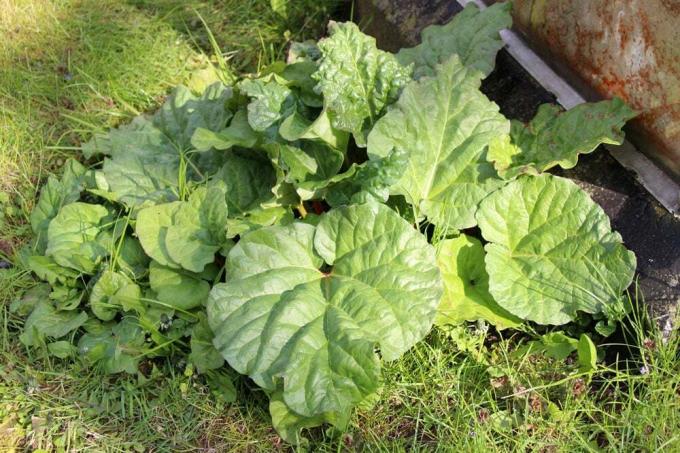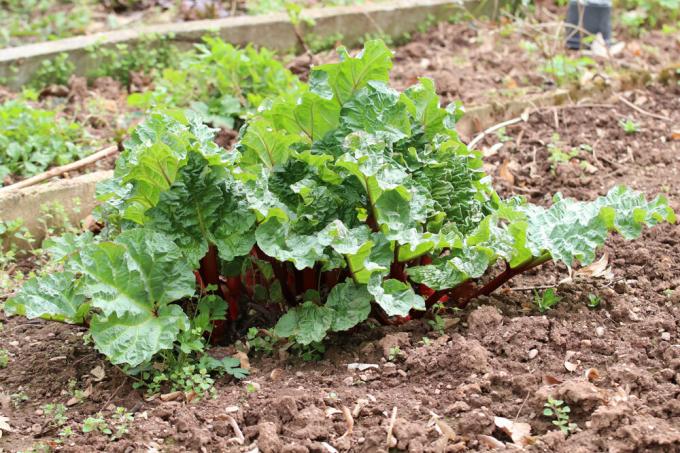

Table of contents
- lighting conditions
- soil condition
- Change of location and space requirements
While vegetables are usually grown annually, rhubarb is a permanent crop. It becomes more powerful year after year and delivers ever higher yields, provided the location is right.
Criteria for site selection
lighting conditions
rhubarb (Rheum rhabarbarum) is, like asparagus and strawberries, a typical spring vegetable. It is not only delicious, but also very healthy thanks to its high vitamin C and fiber content. The ideal vegetable for a spring cure. The conditions at the respective location are decisive for successful cultivation. The common, common, vegetable or curly rhubarb is a real sun worshiper. Accordingly, it prefers sunny, warm and wind-protected locations where it finds the best conditions in suitable soil. If necessary, it also thrives in semi-shade, but then only develops relatively thin stems. Of course, the best possible yields not only require optimal lighting conditions, but also soil conditions that correspond to the requirements of the plant.
soil condition
In its natural habitat, rhubarb thrives on moist, humus and nutrient-rich soil. In order to do justice to this in the garden as well, the soil should first be prepared by digging deep and thoroughly removing all root weeds. Now it's about the quality texture of the soil.
- Rhubarb needs deep, fresh, medium-heavy and humus-rich soil
- Should be good at storing water
- Waterlogged substrates unsuitable
- Soil should be free of harmful nematodes (roundworms).
- Best suited to soils with a pH between 5.6 and 7.2
- Loamy-sandy subsoil are very good
- Work in plenty of leaf humus in sandy soils to increase storage capacity
- Enrichment with compost or manure often makes sense
- Per square meter approx. three liters of compost and three handfuls of horn shavings
- Improve particularly loamy soils with sand or fine gravel
- Cultivation on plowed meadow particularly promising
- After planting, cover area with composted bark
Tip:
Rhubarb is one of the so-called heavy consumers, i. i.e. it has an increased need for nutrients. For this reason, a planting in the immediate vicinity of a compost heap would be recommended, here he finds the most nutrient-rich soil.
Change of location and space requirements

Since this vegetable is a permanent culture, i.e. a perennial culture, it should be able to spread undisturbed over the years. The proximity to other types of vegetables is not a problem, since rhubarb gets along very well with many types. However, it should not be in one and the same place in the garden indefinitely.
- Plant rhubarb at the same location after five years at the earliest
- After 8-10 years at the latest, change location and share stock
- Divide the plant if necessary
- Rheum rhabarbarum needs enough space due to its size
- Minimum for smaller varieties, one square meter of area per plant
- Better for bigger 130x130 cm
- Good neighbors are bush beans, peas, cabbage, lamb's lettuce, spinach, kohlrabi, broccoli
Tip:
Depending on the variety, only the red or green stalks are suitable for consumption, with red-fleshed varieties being particularly aromatic and containing significantly less oxalic acid. Rhubarb should not be eaten raw, only properly prepared.
 Home editorial office
Home editorial office
Learn more about rhubarb

When and with what to fertilize rhubarb?
Properly prepared, rhubarb is a real treat. However, in order to thrive, it needs sufficient nutrients. The right fertilizer plays an important role in this.

How deep is rhubarb rooted? | Root depth information
How deep is rhubarb rooted? Everyone who wants to implement the plant must ask themselves this question. Because the dimensions are important both for digging up the plant and for digging the new planting hole. Here is the answer.

Pruning rhubarb after harvest - how is it pruned?
Rhubarb - which is actually a vegetable - is a popular topping for cakes and tasty as a compote. As a garden plant, however, it poses many a puzzle. This includes the cut. Interested parties can find out when it makes sense and when not.

Transplanting rhubarb | the best time to plant | planting time
Fruity, juicy and full of vitamins - if you plant rhubarb in your garden, you always have an aromatic vegetable at hand for summer desserts or cakes. But when cultivating the popular vegetable, it should be borne in mind that the delicious sticks need to be moved from time to time in order to produce a rich harvest.

Cooking rhubarb jam - basic recipe
Rhubarb, a wonderfully old-fashioned vegetable, is back in fashion, at least in the kitchen. There are now different breeds with green or red flesh and they grow almost by themselves in the garden. Until the 24th It should be harvested and processed by June. The classic is rhubarb jam, and with good reason.

Harvest rhubarb - this is the best harvest time
Rhubarb is a fascinating vegetable that enjoys great popularity and can be found in many private gardens. No wonder: it tastes good, can be used in many ways in the kitchen and is relatively easy to grow. The crux of the matter is usually the harvest and the question of when the harvest can take place. Here are the answers.

